 A Description of the Geology of Virginia
This fractal scaling is the way nature is organized, and when trying to describe a part of nature the problem is deciding at what scale to observe and describe, back at a distance capturing the big picture, or up close capturing the subtleties. This is because even though fractal things retain their complexity at all scales, that does not mean that they look the same at all scales. The big picture and the local outcrop are often different fractal images, and they must be understood and interpreted differently. One of the daunting facts of all this geology becomes apparent when one begins to examine the technical literature. There is so much of it! And it describes the geology at all conceivable scales. We could look at a field guide, for example, that spends pages describing and interpreting a single outcrop, with a long bibliography supporting it. Another paper, though, comparing things on a regional scale may not even refer to any of the details in the field guide stop. They are just too small to be relevant at that larger scale. This can be very frustrating, for truly there is a lot to learn in the details, and a single outcrop is all we can examine at a time, anyway. Yet at the scale of this Virginia geologic history a single outcrop just may not be important, even for as interesting as it is. It also may be true that outcrops may be unique, or many outcrops of the same rocks may each differ significantly. So, just how important is all this vital detail? To a specialist it is the bread and butter of their work; immensely important. And it may even be important in forming our larger interpretations. Sometimes a single outcrop is a key to understanding much more, although such outcrops invariably raise more questions than they answer. So, inevitably, we are going to leave out many things that some feel are crucially important, and may include things others feel are so generalized they are practically useless. Or, we may say things that are so generalized they cannot help but be inaccurate in some way, or violate some evidence and ideas important to someone. We can only apologize on all counts, and hope instead to set up a dialogue to improve the presentation of this history. The basic descriptions of Virginia geology below are mostly from a distance - that is, a scale too large to be visited or seen in one place. It is just the nature of the time and space available. Yet, being curious, once we get a taste of some of the geology and history we almost immediately want to ask, "What would this feature look like if I could visit it?" Or conversely, when visiting some place we want to know where it fits in the larger pictures described here. So, in fact, we must learn to see the different scales simultaneously, the big scales in our mind's eye while looking at individual outcrops or rocks, and vice versa. Another complicating factor in describing the geology is that rocks are always the result of processes, processes that have ceased long, long before the rock is exposed for us to examine. Yet a description is just a description, not an interpretation. But geology would be a sterile subject if we had no appreciation of the processes that produced this rock we are describing. The problem here is that we must learn to look at rocks and see, in our mind's eye, the processes that produced them. For example, the seething, white hot magma that solidifies into the cool granite by the side of the road, or the waves on the ancient beach that formed the sandstone we see in the roadcut. So, even though this page is supposed to be a description of Virginia geology, the descriptions below constantly stray over into interpretations, and we must learn to not confuse the two. Geologists are trained to do both these things, see rocks and realize the fractal scale they are in, or see rocks and imagine the processes active when they formed. It does take practice, but once learned we do it automatically, look at a rock and intuitively know the processes responsible for it. But for the novice this is not always easy. So for the trained person the descriptions and interpretations may seem tedious, but they are there to help everyone understand the geology. On the opposite side, geology is full of technical terms and concepts and the descriptions below contain many of these. We hope they are not so daunting to be discouraging. We will try to provide definitions or links where we can Curious about fractals, see the following: link 1, link 2 , link 3 , link 4 .
Geologic records are organized in at least four ways. 1. TECTONIC HISTORY of the rocks. Tectonics refers to earth movement and the structures that result. Here we divide the rock record into the rifting, mountain building, etc. events that have formed and shaped the rocks. 2. AGE OF THE ROCKS, putting them on a geologic time scale from oldest to youngest. 3. GEOLOGIC PROVINCES; the distribution of various kinds of rocks geographically. 4. PHYSIOGRAPHIC PROVINCES: that is, landforms. For example, the ruggedness of the Blue Ridge mountains, as opposed to the flatness of the coastal plain. Each of these gives a different perspective on the geology. The problem is that even though these divisions overlap, they do not exactly correspond with each other and each must be understood separately at first. The tectonic history divisions are explored in the 1 page, 2 page, and 16 page histories. Here we explore the last three divisions; first combining the discussion on geologic/ physiographic provinces, and then describing the record by geologic age.
 Virginia's landforms are strongly influenced by the geology under them, and they largely but not completely overlap. Nonetheless, the geology and physiography are close enough we can combine them. Where there are exceptions they will be dealt with separately. The map above shows the five northeast to southwest trending belts that make up the state. Arranged side by side, from west to east they are: Allegheny Plateau, Valley and Ridge, Blue Ridge, Piedmont, and Coastal Plain. Each of these provinces more or less extends up and down the east coast from Georgia to New York with Virginia more or less in the middle. That is, our geology is not unique but fits in nicely with our neighbors. Each province is distinct in a number of ways. They are physiographically distinct, that is, in driving from one province to another the landforms change and the countryside has a different appearance. The types of rocks differ; they may be igneous, sedimentary, and/or metamorphic. The structure of the rocks differ; they may be flat lying, or folded and faulted. And finally, the geologic ages of the rocks differ. The combination of these features is unique for each province, and gives each its special character. Allegheny Plateau  This province is found only in the southwest part of Virginia, although much of West Virginia is composed of the plateau. The rocks here are sedimentary, flat lying, and topographically high above sea level relative to the rest of the state. They develop a characteristic dendritic drainage pattern (that is, the stream valleys keep splitting and splitting in a random pattern.) For example, go to the Cumberland map covering parts of northern Virginia and West Virginia. The area mostly in green to the west (left) is the Allegheny plateau in West Virginia, and although some drainages appear organized, in many places they follow no particular pattern, especially in the southwest (lower left).
This province is found only in the southwest part of Virginia, although much of West Virginia is composed of the plateau. The rocks here are sedimentary, flat lying, and topographically high above sea level relative to the rest of the state. They develop a characteristic dendritic drainage pattern (that is, the stream valleys keep splitting and splitting in a random pattern.) For example, go to the Cumberland map covering parts of northern Virginia and West Virginia. The area mostly in green to the west (left) is the Allegheny plateau in West Virginia, and although some drainages appear organized, in many places they follow no particular pattern, especially in the southwest (lower left).The exposed rocks are late Paleozoic in age (Devonian, Mississippian, Pennsylvanian, and in parts of West Virginia, Permian). These rocks were deposited at a time when most of Virginia to the east contained major mountain ranges (Taconic, Acadian and Alleghenian orogenies). Underneath the Devonian rocks are additional flat lying sedimentary rocks of Cambrian, Ordovician and Silurian age. Finally at the bottom of the pile are igneous and metamorphic Grenville basement rocks (1.1 billion years and older.) Valley and Ridge 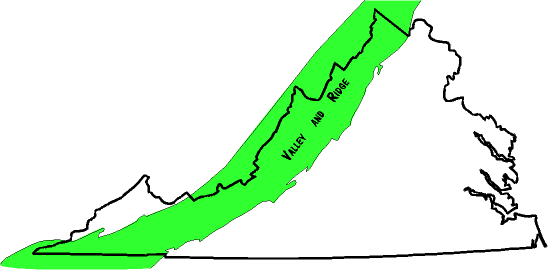 This province lies east of the Allegheny Plateau and west of the Blue Ridge; its western boundary is known as the Allegheny Front and marks an abrupt change from the flat lying rocks of the plateau to the folded/faulted rocks in the valley and ridge. The Allegheny Front boundary can be seen in the Cumberland image as a northeast to southwest diagonal trend separating the parallel blue and green valleys and ridges in the east from the dominantly flat lying green part in the west.
This province lies east of the Allegheny Plateau and west of the Blue Ridge; its western boundary is known as the Allegheny Front and marks an abrupt change from the flat lying rocks of the plateau to the folded/faulted rocks in the valley and ridge. The Allegheny Front boundary can be seen in the Cumberland image as a northeast to southwest diagonal trend separating the parallel blue and green valleys and ridges in the east from the dominantly flat lying green part in the west. The rocks here are sedimentary, thrust faulted and folded into anticlines and synclines, lower and middle Paleozoic in age (Cambrian through lower Mississippian; 16 page history index), and have a trellis drainage pattern. A trellis drainage is when rivers are forced to run parallel to long ridges, almost like a tree espaliered along a fence (see Cumberland image). The ridges exist because they are underlain by hard rock that erodes less easily than the softer rock in the valleys (for example in this cross section, the Massanutten mountain is held up by a resistant sandstone, while Page and Shenandoah valleys to the east and west are underlain by more easily weathered shales and limestones. The lowest part of the stratigraphic section is mostly Cambrian and lower Ordovician carbonates (limestones and dolomites) deposited in tidal flat and coastal environments. Today these are best exposed in the Shenandoah and Page valleys. Most of the rest of the sedimentary rocks are sandstones and shales deposited in deep marine basins during times when the Piedmont region was a large mountain rather than its present flatness. Blue Ridge 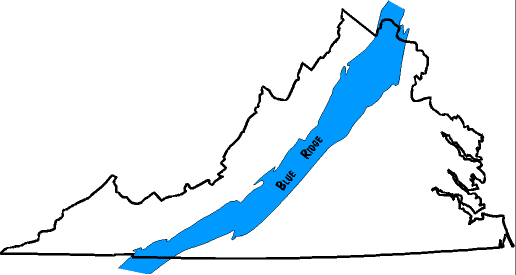 The Blue Ridge province includes both the Blue Ridge mountains (Skyline Drive and the Blue Ridge Parkway), and the strip of land to the east running through Galax, Charlottesville, Culpepper, and Warrenton (map). This is an instance where the physiography and the geology do not exactly correspond. The geologic province is defined primarily by the rocks underlying it, (coarse grained igneous and metamorphic Grenville basement rocks) than its topography (the eastern part of the geologic province blends in topographically with the piedmont in many places, and appears distinct from the Blue Ridge mountains). In northern Virginia the Blue Ridge province crossed by I66 extends from about 5 miles east of Front Royal to Bull Run mountain just west of Manassas. Here it is about 20 miles wide.
The Blue Ridge province includes both the Blue Ridge mountains (Skyline Drive and the Blue Ridge Parkway), and the strip of land to the east running through Galax, Charlottesville, Culpepper, and Warrenton (map). This is an instance where the physiography and the geology do not exactly correspond. The geologic province is defined primarily by the rocks underlying it, (coarse grained igneous and metamorphic Grenville basement rocks) than its topography (the eastern part of the geologic province blends in topographically with the piedmont in many places, and appears distinct from the Blue Ridge mountains). In northern Virginia the Blue Ridge province crossed by I66 extends from about 5 miles east of Front Royal to Bull Run mountain just west of Manassas. Here it is about 20 miles wide.Structurally the Blue Ridge province is a large, eroded anticline overturned to the west (cross section). The core of the anticline is composed of igneous and metamorphic rocks collectively known as the Grenville, although there are also late Proterozoic intrusives and sediments present too. They are the oldest rocks in the state at 1.1 billion (and a protolith [earlier rock now modified to something else] back to 1.8 billion). The east and west flanks of the anticline are much younger volcanics (Crossnore event) and clastic sediments. The clastic sediments fill rift grabens on the northwest and southeast flanks of the anticline (Lynchburg, Ocoee, Grandfather Mtn., Mt. Rogers Groups). Stratigraphic thicknesses range from about 3000 meters to 7000 meters. The final filling of the graben and creation of a divergent continental margin is preserved in the metamorphosed lava flows (Catoctin formation) and sedimentary rocks (Chilhowee Group and Evington formation) about 570-600 million years old (Blue Ridge cross section). The Crossnore igneous suite includes a volcanic pile (Mt Rogers in the south) and granite batholiths (Robertson River) intruding into Grenville plutons. Piedmont 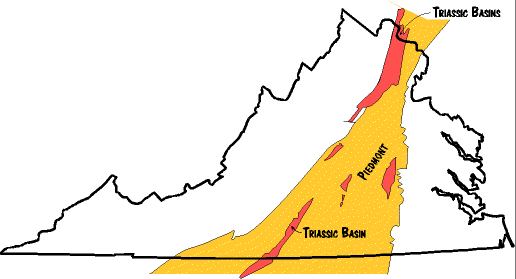 The Piedmont, because it is now relatively flat and topographically featureless, may seem geologically uninteresting to drive across, but it contains some of the most fascinating rocks in Virginia. There are two distinct divisions to the piedmont rocks, one a set of Late Proterozoic and Paleozoic igneous and metamorphic rocks (tan color on the map), and a second of lower Mesozoic (Triassic) sedimentary rocks (red on the map) deposited in graben basins faulted into the igneous and metamorphic rocks.
The Piedmont, because it is now relatively flat and topographically featureless, may seem geologically uninteresting to drive across, but it contains some of the most fascinating rocks in Virginia. There are two distinct divisions to the piedmont rocks, one a set of Late Proterozoic and Paleozoic igneous and metamorphic rocks (tan color on the map), and a second of lower Mesozoic (Triassic) sedimentary rocks (red on the map) deposited in graben basins faulted into the igneous and metamorphic rocks.The Late Proterozoic and Paleozoic igneous and metamorphic rocks include three main components. First, the roots of several volcanic island chains such as in the Charlotte/Chopawamsic belt, and Carolina slate and Eastern slate belts (map); second; several small continental fragments that are possibly Grenville in age (1.1-1.0 bya) (Sauratown Mountain in the south and Raleigh/Goochland belt running west of Richmond (map); and third, the Inner piedmont belt running just east of the Blue Ridge Province (map, or Blue Ridge cross section). The volcanic arcs in their day were comparable to volcanic islands like Japan, Borneo and Sumatra, and the Aleutian Islands. Many, more likely all, of these formed somewhere else and were brought to Virginia by later events. They are said to be allochthonous; rocks still in the place they formed are autochthonous. The Grenville age (?) rocks may be microcontinental fragments torn loose and left behind during the Proto-Atlantic rifting, or continental fragments brought in from elsewhere. They contain high grade metamorphic rocks and igneous intrusions (for example the State Farm pluton at 1.0 billion in the Raleigh/Goochland belt (map). The Inner piedmont belt contains rocks on the SE flank of the Blue Ridge anticline. They are sediments (metamorphosed to greenschist and amphibolite) represented by the Evington/Alligator Back formations (cross section), and mafic-ultramafic igneous bodies scattered along the whole length that represent old oceanic lithosphere (ophiolite suite). This is most likely a fragment of the Proto-Atlantic divergent continental margin In addition, numerous late Paleozoic granite intrusions cut through the region, mostly in the eastern half. These were generated in the Taconic orogeny (e.g. Petersburg granite dated at 320 mya; map), and the Alleghenian orogeny. Because these rocks have been deformed and metamorphosed, often several times, they are very complex. They also contain many economically important mineral deposits, including gold, talc, kyanite, and feldspar. 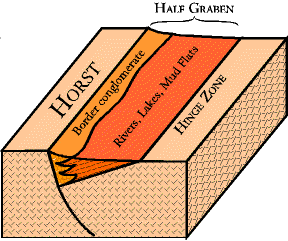 TRIASSIC BASINS The lower Mesozoic sediments deposited in fault basins are usually referred to as Triassic basin deposits, although they are now known to also contain lower Jurassic rocks. These basins formed when Africa separated from North America to create the Atlantic ocean. The Culpepper basin in the western piedmont near the Blue Ridge province is the largest, but numerous smaller basins including the Richmond, Farmville, and Danville are scattered throughout the piedmont. TRIASSIC BASINS The lower Mesozoic sediments deposited in fault basins are usually referred to as Triassic basin deposits, although they are now known to also contain lower Jurassic rocks. These basins formed when Africa separated from North America to create the Atlantic ocean. The Culpepper basin in the western piedmont near the Blue Ridge province is the largest, but numerous smaller basins including the Richmond, Farmville, and Danville are scattered throughout the piedmont.Structurally these are half-graben with a main fault only on the western side. Sometimes you know you have crossed into one of these basins because the rocks turn red, or there are coal beds, but often the evidence is subtler. Cutting into the Triassic-Jurassic sediments are numerous igneous dikes, stocks (small bodies of igneous rock), and lava flows that accompanied the volcanic activity accompanying the opening of the Atlantic ocean. All in all, the piedmont contains evidence of a complex history of many intense geologic forces. Coastal Plain 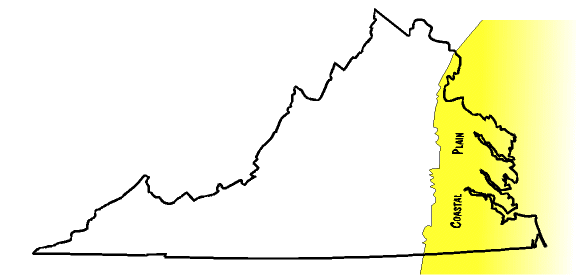 These are mostly unconsolidated or partially consolidated sediments deposited along a coastline not significantly different from that which exists on the coast of Virginia today. The deposition on the present continental margin is a continuation of the coastal plain deposition which has been going on since the Triassic. If we could see the coastal plain sediments in a cross section they would look like a wedge, thick to the east and thinning to a feather edge on the west (cross section M). But the cross section would also show that the Triassic basins found in the piedmont extend under the coastal plain, and indeed the present Atlantic ocean basin is the enlarged eastern most Triassic basin.
These are mostly unconsolidated or partially consolidated sediments deposited along a coastline not significantly different from that which exists on the coast of Virginia today. The deposition on the present continental margin is a continuation of the coastal plain deposition which has been going on since the Triassic. If we could see the coastal plain sediments in a cross section they would look like a wedge, thick to the east and thinning to a feather edge on the west (cross section M). But the cross section would also show that the Triassic basins found in the piedmont extend under the coastal plain, and indeed the present Atlantic ocean basin is the enlarged eastern most Triassic basin.HUMAN HISTORY and GEOLOGIC HISTORY: Not only are landforms controlled by the underlying geology, but we are also controlled by the geology. This link shows a little bit how human and geologic history interweave (link).
|
Virtually the entire geology of Virginia has been compressed, folded, thrust faulted, and telescoped so that most of the rocks have been moved from their site of origin and stacked like a shuffled and bent deck of cards. The exceptions are the Allegheny Plateau and the Coastal Plain. Eventually, if we are to understand Virginia geologic history, we will have to undo all of this. For example, the Grenville igneous and metamorphic rocks now found exposed in the Blue Ridge also underlie most of eastern North America, buried under the sedimentary rocks. On the other hand, the Grenville rocks in the Blue Ridge are not now located where they originally formed. Their original location was somewhere to the east, perhaps as far as Richmond, and they were transported to their present location during the Alleghenian orogeny along a major thrust fault (cross section). Indeed most of the rocks in the Blue Ridge and Piedmont have been transported from their original locations. Furthermore, most of the piedmont rocks are not originally part of North America in the first place but have been added in pieces during the Paleozoic, and each of these pieces has its own tectonic history that may or may not correspond with the timing of the events in the rest of Virginia. On the other hand, the lower and middle Paleozoic sedimentary rocks of the Valley and Ridge do not stop at the Blue Ridge. They extend far to the east under the Blue Ridge and Piedmont (cross section). Or to put it another way, the piedmont and Blue Ridge have been thrust faulted over the Cambrian-Ordovician DCM sediments. |
| |
|||
| Last Update: 9/13/00 | |||